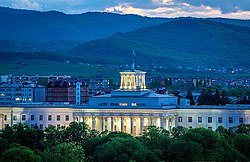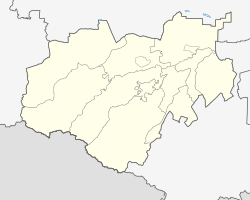Nalchik
| Nalchik (English) Нальчик (Russian) Налщӏэч (Kabardian) Нальчик (Balkar) |
|
|---|---|
| - City - | |
 Nalchik |
|
 Location of the Kabardino-Balkar Republic in Russia |
|
|
|
|
|
|
|
|
|
|
| City Day | September 1 |
| Administrative status (as of October 2008) | |
| Country | Russia |
| Federal subject | Kabardino-Balkar Republic |
| Administratively subordinated to | city of republic significance of Nalchik |
| Capital of | Kabardino-Balkar Republic |
| Administrative center of | city of republic significance of Nalchik |
| Municipal status (as of January 2011) | |
| Urban okrug | Nalchik Urban Okrug |
| Administrative center of | Nalchik Urban Okrug |
| Head | Zalimgeri Khagasov |
| Representative body | City Council |
| Statistics | |
| Area | 67 km2 (26 sq mi) |
| Population (2010 Census) | 240,203 inhabitants |
| - Rank in 2010 | 78th |
| Density (January 1, 2010) | 2,234.3/km2 (5,787/sq mi) |
| Time zone | MSK (UTC+03:00) |
| Founded | 1724 |
| City status since | 1921 |
| Postal code(s) | 360000, 360005, 360032, 360901, 360903, 360904 |
| Dialing code(s) | +7 8662 |
|
|
|
| on | |
Nalchik (Russian: Нальчик; IPA: [ˈnalʲtɕɪk]; Kabardian: Налщӏэч /naːɮɕʼakʲ/; Karachay-Balkar: Нальчик) is the capital city of the Kabardino-Balkar Republic, Russia, situated at an altitude of 550 meters (1,800 ft) in the foothills of the Caucasus Mountains; about 100 kilometers (62 mi) northwest of Beslan in the Republic of North Ossetia–Alania. It covers an area of 131 square kilometers (51 sq mi). Population was 240,203 (2010 Census);274,974 (2002 Census);234,547 (1989 Census).
The territory of modern-day Nalchik was formerly known as Slabada. It was inhabited by native Kabardians, Balkars, Chechens, Adeki, and Cherkese until around 1743: groups occasionally clashed over and dispute their claims to the land. The modern city dates from the early 19th century when the expanding Russian Empire built a fort there together with settling Mountain Jews in 1818; this date is seen at the top of the city's coat of arms. With the founding of the city of Nalchik, the disputes among the native groups calmed and life improved for the people in the region.
...
Wikipedia



